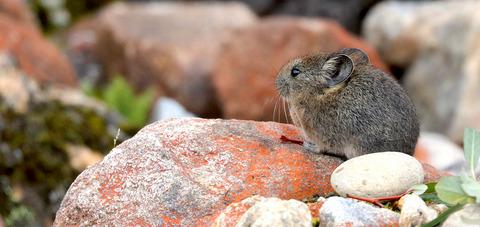当前位置:
X-MOL 学术
›
Funct. Ecol.
›
论文详情
Our official English website, www.x-mol.net, welcomes your
feedback! (Note: you will need to create a separate account there.)
Divergent adaptations in resource‐use traits explain how pikas thrive on the roof of the world
Functional Ecology ( IF 4.6 ) Pub Date : 2020-07-14 , DOI: 10.1111/1365-2435.13609 Anderson Feijó 1 , Deyan Ge 1 , Zhixin Wen 1 , Lin Xia 1 , Qisen Yang 1
中文翻译:

资源利用特征的不同适应性解释了鼠兔如何在世界屋顶上蓬勃发展
更新日期:2020-07-14
Functional Ecology ( IF 4.6 ) Pub Date : 2020-07-14 , DOI: 10.1111/1365-2435.13609 Anderson Feijó 1 , Deyan Ge 1 , Zhixin Wen 1 , Lin Xia 1 , Qisen Yang 1
Affiliation

|
- Life in extreme environments is possible through multilevel adaptations to physical and biotic stresses. At high elevations, species face numerous challenges, besides low oxygen levels, but previous studies have focused on genetic and physiological adaptations to chronic hypoxia while overlooking other key strategies for thriving in alpine landscapes.
- Here, we investigate resource‐use trait adaptations to extreme elevations using pikas as a model, lagomorphs distributed up to 6,200 m and reaching maximum diversity on the Qinghai‐Tibet plateau, the highest plateau on Earth. Specifically, we assess cranial evolution in pikas using geometric morphometric and phylogenetic comparative techniques to determine whether adaptations among high‐elevation biota shown at the molecular and physiological levels also occur in resource‐use traits. We further explore the roles of two contrasting lifestyles (burrowing and rocky‐dwelling) in cranial evolution.
- We found that alpine species exhibit striking phenotypic specialization to distinct microhabitats. Contrary to physiological and genetic adaptive convergence, we show that the cranium has undergone adaptive divergence likely reflecting past resource competition in highlands and long‐term association with alpine landscapes. Our analyses also reveal that the evolution of burrowing lifestyle allows high‐elevation pikas to explore novel niches and boosts their phenotypic diversification. In addition to cold and hypoxia tolerance, high cranial specialization, the appearance of burrowing habits and strong niche separation explain how pikas overcome alpine stresses and flourish on the highest plateau on Earth. By contrast, when moving to spatially complex and heterogeneous vegetation zonation, pikas exhibit generalist skull forms able to exploit diverse habitats. These findings mirror previously reported intraspecific patterns in mammals, suggesting a general morphological response in resource‐exploiting traits to cope with distinct selection pressures across elevation zones. Phenotypic diversity is further constrained by rocky habitats, resulting in convergent skulls.
- Our study highlights that adaptations to extreme environments occur at multiple levels of organization, but can lead to distinct evolutionary paths depending on which selective forces they respond to. The evolution of burrowing behaviour represents a landmark in the evolutionary history of pikas. We further show that rocky habitats impose strong ecological pressures, leading to convergent responses in resource‐use traits, which is rarely documented in mammals.
中文翻译:

资源利用特征的不同适应性解释了鼠兔如何在世界屋顶上蓬勃发展
- 通过对生理和生物压力的多层次适应,可以在极端环境中生活。在高海拔地区,物种除了低氧水平外还面临许多挑战,但是先前的研究集中于对慢性缺氧的遗传和生理适应,同时忽略了在高山景观中繁衍的其他关键策略。
- 在这里,我们使用皮卡树作为模型,研究了资源利用性状对极端海拔的适应性,在地球上最高的高原青藏高原上,分布达6,200 m并达到最大多样性的泻湖型。具体而言,我们使用几何形态计量学和系统发育比较技术评估了鼠兔的颅骨进化,以确定在分子和生理水平上显示的高海拔生物群之间的适应性是否也发生在资源利用性状中。我们进一步探讨了两种截然不同的生活方式(穴居和岩居)在颅骨进化中的作用。
- 我们发现高山物种对不同的微生境表现出惊人的表型专长。与生理和遗传适应性收敛相反,我们发现颅骨经历了适应性发散,这可能反映了过去高原上的资源竞争以及与高山景观的长期联系。我们的分析还表明,穴居生活方式的演变使高海拔的鼠兔能够探索新颖的生态位并促进其表型多样化。除耐寒和耐缺氧外,高颅颅专业性,穴居习惯的出现和强大的生态位分离也解释了鼠兔如何克服高山压力并在地球上最高的高原上繁衍生息。相反,当转向空间复杂且异质的植被分区时,皮卡犬表现出能够开发各种栖息地的通体头骨形式。这些发现反映了以前报道的哺乳动物种内模式,表明在资源利用性状中存在一般的形态学反应,以应对跨越海拔地区的不同选择压力。表型多样性进一步受到岩石生境的限制,导致头骨融合。
- 我们的研究强调,对极端环境的适应发生在组织的多个层次上,但取决于它们所响应的选择力,它们可以导致不同的进化路径。穴居行为的演变代表了鼠兔进化史上的一个里程碑。我们进一步表明,多岩石的栖息地施加了强大的生态压力,导致资源利用特征的收敛反应,而哺乳动物很少对此进行记录。











































 京公网安备 11010802027423号
京公网安备 11010802027423号